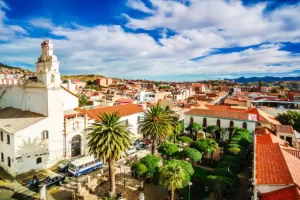Sucre, Bolivia’s constitutional capital, is a city rich in history, stunning architecture, and vibrant culture. Known as the “White City” for its well-preserved colonial buildings, Sucre is a UNESCO World Heritage Site and a haven for travelers seeking a blend of cultural exploration and relaxation.
Essential Information
- Location: South-central Bolivia.
- Altitude: Approximately 2,810 meters (9,220 feet) above sea level.
- Currency: Boliviano (BOB).
- Language: Spanish, with Quechua and Aymara spoken by indigenous communities.
- Best Time to Visit: April to November, during the dry season, for pleasant weather.
Interesting Facts
- Founding: Sucre was founded in 1538 as “La Plata” and later renamed in honor of Antonio José de Sucre, a leader of South American independence.
- Independence Movement: The city is known as the birthplace of Bolivia’s independence, with the first revolutionary cry in 1809.
- Dinosaurs: Sucre is home to one of the world’s largest collections of dinosaur footprints at Cal Orck’o.
- White City: The city’s colonial center is a showcase of pristine whitewashed buildings.
- Mild Climate: Sucre’s temperate weather is often called the “City of Eternal Spring.”
How to Get There
By Air
- Alcantarí International Airport (SRE): Located 30 km from the city center, with flights from La Paz, Santa Cruz, and Cochabamba.
By Bus
- Long-distance buses connect Sucre to major Bolivian cities. Overnight buses are common from La Paz and Santa Cruz.
With Train
- The train system doesn’t directly reach Sucre, but nearby Potosí offers rail connections.
Best Things to Do
- Explore Plaza 25 de Mayo: The central square surrounded by historic buildings, cafes, and museums.
- Visit Casa de la Libertad: The birthplace of Bolivia’s independence, showcasing artifacts and historical documents.
- Marvel at La Recoleta: A serene area offering panoramic views of the city and a beautiful convent.
- Discover Parque Cretácico: Home to thousands of preserved dinosaur footprints at Cal Orck’o.
- Learn at Museo de Arte Indígena ASUR: A fascinating insight into indigenous textiles and crafts.
- Hike to Cerro Churuquella: A rewarding hike to a hilltop with breathtaking views and a peaceful atmosphere.
Best Accommodation Options
Luxury
- Parador Santa Maria La Real: A restored colonial mansion with elegant decor and excellent service.
- Hotel Villa Antigua: A charming boutique hotel with a rooftop terrace and lush gardens.
Mid-Range
- Hotel Monasterio: A cozy stay in a converted monastery with modern amenities.
- Hostal de Su Merced: Known for its historic charm, friendly staff, and lovely rooftop views.
Budget
- KulturBerlin: A lively hostel with cultural events and budget-friendly rooms.
- Casa Verde B&B: A clean and comfortable option with a warm and welcoming atmosphere.
Cultural and Modern Attractions
- Cathedral of Sucre: A striking colonial-era cathedral located at Plaza 25 de Mayo.
- Ethnographic and Folklore Museum: Showcasing traditional Bolivian costumes and music.
- Mercado Central: A vibrant market for fresh produce, local dishes, and traditional crafts.
- Universidad de San Francisco Xavier: One of the oldest universities in the Americas, with impressive architecture.
Dining and Nightlife
Dining
- La Taverne: A French-Bolivian fusion restaurant offering gourmet dishes.
- Condor Café: A vegetarian-friendly spot with a focus on sustainability.
- Café Mirador: Enjoy delicious meals with stunning views over the city.
Nightlife
- Joy Ride Café: A lively venue for drinks, dancing, and meeting fellow travelers.
- Bibliocafé Classica: A relaxed bar with an extensive drink menu and cozy atmosphere.
- KulturBerlin: Often hosts themed parties and cultural events.
Day Trips
- Tarabuco Market: Visit this famous Sunday market for traditional weavings and handicrafts.
- Cajamarca: A serene village with hiking trails and picturesque views.
- Maragua Crater: Explore a unique geological formation and surrounding hiking trails.
- Potolo and Jatun Yampara: Discover traditional villages preserving Andean culture.
Getting Around
- Walking: Most attractions in the city center are within walking distance.
- Taxis: Widely available and inexpensive; ideal for longer distances.
- Micros and Trufis: Affordable minibuses that operate fixed routes throughout the city.
- Bike Rentals: A scenic way to explore the outskirts of Sucre.
Practical Tips
- Acclimatization: Although lower than La Paz, Sucre’s altitude still requires gradual adjustment.
- Local Currency: Have small bills and coins for markets and transportation.
- Safety: Sucre is relatively safe, but always stay vigilant in crowded areas.
- Pack Layers: The temperature can vary significantly between day and night.
- Language: Learning basic Spanish phrases can enhance your interactions.
Conclusion
Sucre, Bolivia’s “White City,” offers an immersive journey through history, culture, and natural beauty. With its stunning architecture, vibrant markets, and serene atmosphere, Sucre is a must-visit destination that perfectly balances relaxation and exploration. Whether you’re delving into its rich past or enjoying its modern comforts, Sucre promises an unforgettable experience.

